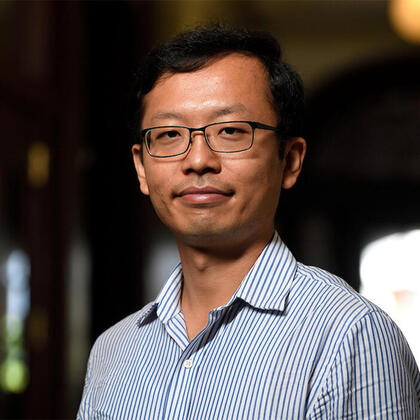- Name
- Johns Hopkins Media Relations
- jhunews@jhu.edu
- Office phone
- 443-997-9009
Electrical storms and volcanic lightning are spectacular displays of electric energy released from turbulent air. In these phenomena, tiny particles—including ice crystals, volcanic ash, and dust—collide and gain electrical charges, like static from walking on a carpet. As charges build up in different areas, the imbalance can set the stage for dramatic lightning displays.

Image caption: Rui Ni
Image credit: Will Kirk / Johns Hopkins University
Supported by a five-year, $1.25 million grant from the Gordon and Betty Moore Foundation's Experimental Physics Investigators Initiative, Rui Ni, associate professor of mechanical engineering at Johns Hopkins University and researcher at the Whiting School of Engineering's Ralph O'Connor Sustainable Energy Institute, will reproduce these electrified storms in his lab. His goal is to understand how chaotic air movement in storms—called background turbulence—influences the formation and behavior of lightning.
"We think the answer may lie in how turbulence brings certain particles together and converts some of the kinetic energy into electrostatic potential," Ni said. "Turbulence consists of coherent internal structures with different sizes that can interact and select particles of certain density and size. Different particles may be segregated into separate areas, thereby increasing the overall electrostatic field."
Ni is one of 19 researchers named to the Moore Foundation's 2024 cohort. The initiative is designed to support novel and potentially high-payoff projects that will advance the field of physics but might be hard to fund through traditional funding sources, allowing the investigators to explore new and uncharted areas and advance the scientific understanding of the natural world.
Ni said this research on charge segregation in particle-laden turbulent flows will improve understanding of geophysical events, such as lightning, volcanoes, and dust storms. In addition, the study's findings could also improve industrial processes where electrically charged particles are used, including methods of chemical production, air pollution control, surface coating, and drug manufacturing.
Ni directs the Fluid Transport Laboratory, which is dedicated to the study of turbulent multiphase flows, a branch of fluid dynamics that focuses on the physics governing applications where the fluid is often seeded or contaminated with gas bubbles, oil droplets, solid particles, and more. His previous honors include an NSF CAREER award, ACS PRF New Investigator award, and a NASA Early Stage Innovation award.







